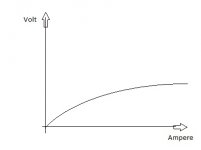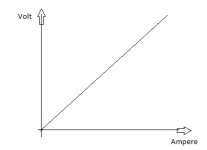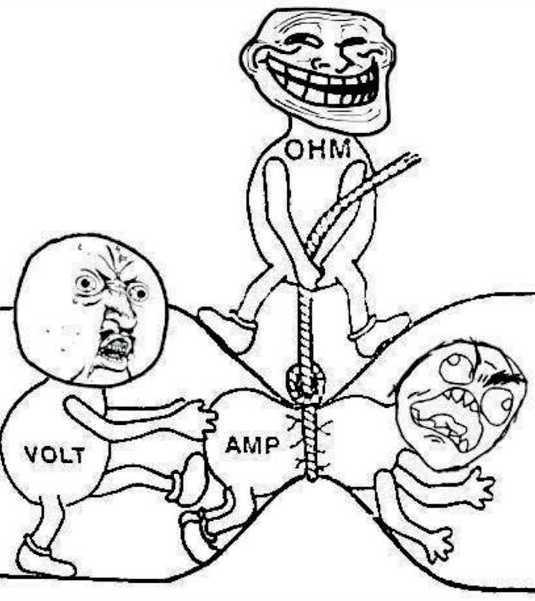Hi all,
I was wondering... if an amplifier psu tensions for a 100w rms 8 ohm is about, let's say, 30v and -30v then for a 200w it would be 60v and for an amplifier that can put 1500w into 8 ohm , it would be much more then, let's say, 100v and -100v. Yet i've been searching for amplifiers on the web and i found one board mono that can put 1500w into 8 ohm and yet it only requires a +-100vdc (around that) to work... So if we graph the output of an audio amplifier ( the relationship between tension and current ) should be exponential like this, right ?

... and not a straight line like this, right ?

Thank you all,
Cheers.
I was wondering... if an amplifier psu tensions for a 100w rms 8 ohm is about, let's say, 30v and -30v then for a 200w it would be 60v and for an amplifier that can put 1500w into 8 ohm , it would be much more then, let's say, 100v and -100v. Yet i've been searching for amplifiers on the web and i found one board mono that can put 1500w into 8 ohm and yet it only requires a +-100vdc (around that) to work... So if we graph the output of an audio amplifier ( the relationship between tension and current ) should be exponential like this, right ?

... and not a straight line like this, right ?

Thank you all,
Cheers.
Lets see:
100W & 8ohm = 28Vrms or 40V peak (remember to add headroom to the power supply)
200W & 8ohm = 40Vrms or 56V peak
1500W & 8ohm = 110Vrms or 154V peak
630W & 8ohm = 71Vrms or 100V peak
Many in the US think of voltage, reserving tension for the power company high tension wires.
100W & 8ohm = 28Vrms or 40V peak (remember to add headroom to the power supply)
200W & 8ohm = 40Vrms or 56V peak
1500W & 8ohm = 110Vrms or 154V peak
630W & 8ohm = 71Vrms or 100V peak
Many in the US think of voltage, reserving tension for the power company high tension wires.
Hmm... how should I start...
- The red graph is logarithmic; the blue graph is exponential

- Volt vs amp should be a straight line
- Power is V^2 / R
- BTL config can produce 4 times output power of single-ended config for the same supply voltage and assuming unlimited current capability
- "Peak power" is twice of RMS power
- Sellers pulling power figures out from their blackholes
- The red graph is logarithmic; the blue graph is exponential

- Volt vs amp should be a straight line
- Power is V^2 / R
- BTL config can produce 4 times output power of single-ended config for the same supply voltage and assuming unlimited current capability
- "Peak power" is twice of RMS power
- Sellers pulling power figures out from their blackholes
Hello, thanks,
... Because it comes to a point that is impossible to hear, there is also no equipment that supports so many db's and it would be a problem ( or impossible ) to build the power supply. Right ? So as voltage increses, current will increase more in logaritmic form, right ? Volume tends to a value ? I've noticed that the scale around the volume pot of an amplifier is not allways equal. Per example, the first 25% of rotation of the pot will amplify more than the last 25%. I don't know if this has anything to do with the relationship between tension and current but i think it has, right ? Thanks
... Because it comes to a point that is impossible to hear, there is also no equipment that supports so many db's and it would be a problem ( or impossible ) to build the power supply. Right ? So as voltage increses, current will increase more in logaritmic form, right ? Volume tends to a value ? I've noticed that the scale around the volume pot of an amplifier is not allways equal. Per example, the first 25% of rotation of the pot will amplify more than the last 25%. I don't know if this has anything to do with the relationship between tension and current but i think it has, right ? Thanks
Last edited:
Roughly speaking 1000W is twice as loud as 100W which is twice as loud as 10W and so onHello, thanks,
... Because it comes to a point that is impossible to hear, there is also no equipment that supports so many db's and it would be a problem ( or impossible ) to build the power supply. Right ?
no it's a linear relationshipSo as voltage increses, current will increase more in logaritmic form, right ?
It's because most volume pots have an inaccurate logarithmic track resistanceVolume tends to a value ? I've noticed that the scale around the volume pot of an amplifier is not allways equal. Per example, the first 25% of rotation of the pot will amplify more than the last 25%. I don't know if this has anything to do with the relationship between tension and current but i think it has, right ? Thanks
Hi all,
I was wondering... if an amplifier psu tensions for a 100w rms 8 ohm is about, let's say, 30v and -30v then for a 200w it would be 60v and for an amplifier that can put 1500w into 8 ohm , it would be much more then, let's say, 100v and -100v. Yet i've been searching for amplifiers on the web and i found one board mono that can put 1500w into 8 ohm and yet it only requires a +-100vdc (around that) to work... So if we graph the output of an audio amplifier ( the relationship between tension and current ) should be exponential like this, right ?
View attachment 641962
... and not a straight line like this, right ?
View attachment 641963
Thank you all,
Cheers.
The volts versus amps is linear, it is related by the constant load of (in this case) 8 ohms. V = I*R, ohms' law. So your 1st graph is not correct, the 2nd is.
If you want to double the output power you do NOT have to double the voltage - because power is V-squared / R. So to double power you only need SqRt(2) * V, about 1.4 times larger (because 1.4 squared is about 2).
Jan
As Scott said, volume control "% rotation" isn't really a measure of anything at all. Different tapers and different amounts of gain quickly make it meaningless other than "more clockwise is louder".
One thing I hear that I always have to restrain myself from jumping in about is when someone says "It's really loud and the volume control is only X% of the way!". It's pretty dang trivial to arrange gains and signal level so you run out off power in the first 1% of rotation if you wanted to!
One thing I hear that I always have to restrain myself from jumping in about is when someone says "It's really loud and the volume control is only X% of the way!". It's pretty dang trivial to arrange gains and signal level so you run out off power in the first 1% of rotation if you wanted to!
I already understand... i already suspected that the pots resistence is logaritmic/exponential. I mean, when i turn from 0% to 25%, the the resistence at 0% minus the resistence at 25 % , is bigger than the last 25%.
And yes, now i'm thinking more clearly and i understand that is the power that isn't directly proporcional not the relationship between tension and current.
Thanks all.
And yes, now i'm thinking more clearly and i understand that is the power that isn't directly proporcional not the relationship between tension and current.
Thanks all.
This is what I meant by the log pot being inaccurate, the red line is a "commercial log pot" Potentiometers (Beginners' Guide to Pots)
....it comes to a point that is impossible to hear, there is also no equipment that supports so many db's and it would be a problem ( or impossible ) to build the power supply. Right ?
No.
Go to your local electric guitar shop. They can sell you a 3,000 Watt amplifier for under $999, no problem. (In a small town, they might have to order it for you.)
Go to a BIG rock music concert. Last I looked, 10,000 Watts was a small system. It is not hard to build a 10,000 Watt amplifier (if you are very experienced). It is a little hard to build a "good" loudspeaker which can use that much power, and in BIG venues it is very useful to use arrays of speakers so that they can be aimed to cover the audience (and not the tin ceiling). "Modular". Dozens of drivers and dozens of 2,000W amps.
I have seen a 3,000 Watt system sold to a 150 seat church. It was the base module for a system that would be used for arrays in 1,000 seat theaters and large drink/dance venues. I thought it was over-kill for a medium church, but it was very well designed and they won't lack for clean power.
And consider DC power lines. AC is handy for large electric power over long distances, but it has problems for very long distances or between unsynchronized sources. They convert AC to DC, send it over the wire, then convert the DC to AC for local uses. The DC-AC conversion "IS" an audio power amplifier, within limits. They are normally run at 50/60Hz (an audio bass frequency) but they actually run at the Hz they are told to. Mercury-tank and thyristors might not go over 200Hz, but IGBTs, GTOs, and IGCTs can switch faster, and MOSFETs can be stacked. 4,000 MEGAwatts is not unusual for these systems.
So it "can" be done. The problem is that audio amplifier cost rises faster than the loudness. And historical trends. In 1928 only a rich man could afford a One Watt amplifier. In 1950 a 10 Watt was affordable; in the 1970s 30W was a start and 400 Watt amplifiers were in some homes. Today, as you note, 100W modules and their power supplies are stupidly cheap from Asia. Which is also where the 3000W/$999 rock-shop amps come from.
As Scott said, volume control "% rotation" isn't really a measure of anything at all. Different tapers and different amounts of gain quickly make it meaningless other than "more clockwise is louder".
One thing I hear that I always have to restrain myself from jumping in about is when someone says "It's really loud and the volume control is only X% of the way!". It's pretty dang trivial to arrange gains and signal level so you run out off power in the first 1% of rotation if you wanted to!
Then there was the guy who sold potmeter knobs that went to 11! Really really loud!
Jan
i understand that is the power that isn't directly proporcional not the relationship between tension and current.
Thanks all.
Not wanting to split hairs, but it IS directly proportional. It just isn't linear.
Jan
Power = (V^2)/R, so the graph of the power in relationship to voltage isn't a straight line, that's what i mean...
I mean a stereo powerfull amplifier ( with a normal structure design, like most stereo amplifiers ) that can be build to work with your home electrical capabilities...
like two of these boards:
Hifi 1500W Powerful Assembled Mono Amp Board with 28 Tubes 14xTTC5200 14xTTA1943 | eBay
I mean a stereo powerfull amplifier ( with a normal structure design, like most stereo amplifiers ) that can be build to work with your home electrical capabilities...
like two of these boards:
Hifi 1500W Powerful Assembled Mono Amp Board with 28 Tubes 14xTTC5200 14xTTA1943 | eBay
Is it possible to feed two of these boards with one psu ? It exists psu's with that capabilities for sell ? In my country the electrical home net is 230vac 50hz and i have 15 A or 20 A ( i'm not shure now ... )
Google is your friend. First determine how much power supply voltage and current you need for the amplifier power you want.
Jan
- Status
- This old topic is closed. If you want to reopen this topic, contact a moderator using the "Report Post" button.
- Home
- General Interest
- Everything Else
- Releationship between tension and current in audio signals
